Taking a measure of toll on birds
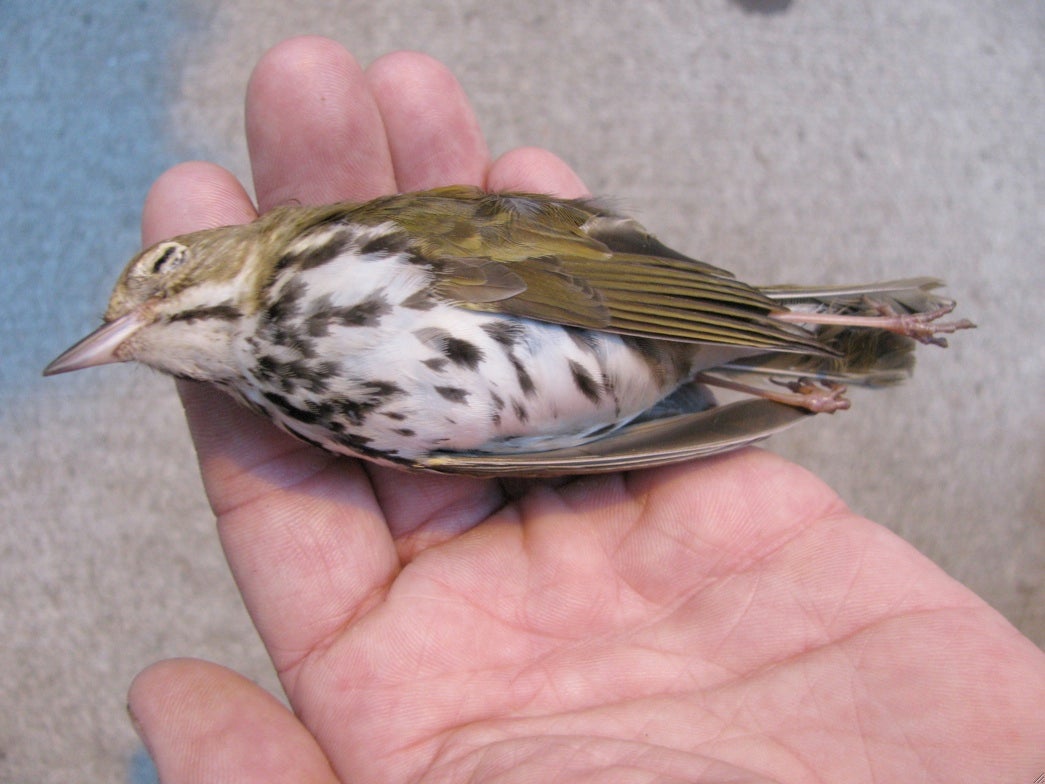
Female warbler found in Center City / Stephen Maciejewsk
May 21
By Kellie Patrick Gates
For PlanPhilly
It’s 5:25 on a dreary Monday in Center City, and the chirps of birds just waking up in the landscaping punctuate the rain.
But Philadelphia Bird Collisions Monitoring Project volunteer Steve Levin isn’t up early to check on the birds that are singing and foraging. He’s here to count and collect dead ones – migrants who died when they flew into a pane of glass.
Birds die this way everywhere, and some cities, including Toronto, Chicago and New York, have programs aimed at protecting these seasonal travelers. Levin, 61, and a team of 21 other volunteers led by Pennsylvania Audubon outreach coordinator Keith Russell, hope the information they gather during this and the next several migrations will help convince city officials, building managers, business leaders and others that Philadelphia needs a program, too.
The Bird Collisions volunteers began their spring monitoring on April 20. Since then, one of them has been out nearly every morning, looking for birds who have died on Levin’s Center City route and a second route at Temple University. Temple faculty and administrators noticed a considerable amount of dead birds on campus and asked to be part of the study. Russell hopes Temple will also be a test site for possible solutions, which could be duplicated around the city.
But Russell says it’s not possible to develop solutions before learning more about the local problem. And so Levin began his rounds on that rainy day in early May.
Levin first took a sheet of paper out of his back pack and noted his starting time (5:30 a.m.), the weather conditions (rainy and foggy) and the moon (not visible), and then began his weekly route along the bases of several tall, heavily glassed buildings and other structures. Russell and his team asked that the identity and precise location of these buildings not be revealed. They don’t want the building owners to feel like they are being targeted. The bird monitors also don’t want anyone to take the dead birds away before they get there. And they hope that if they can show the owners there’s a problem, they, like Temple, will want to find a solution.
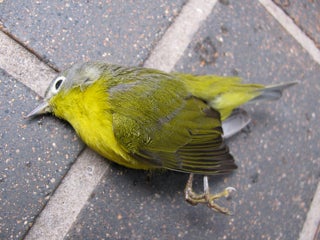
Nashville warbler
A common fix in other cities is a lights-out program, where as many building lights as safety allows are turned off at night, especially during the spring and fall migrations. Birds use the stars to navigate, and experts say they can sometimes be confused by lights at the top of buildings, especially on cloudy nights. In other instances, lights illuminate a lobby full of plants and water features that birds find attractive. The birds die trying to fly to the plants or water, because they do not see the glass.
Russell isn’t yet certain the role that lights play in Philadelphia. But he is sure that glass is playing a role, whether birds are trying to fly inside a building for shelter, or because they become confused by reflections of trees that are outside a building. Some places, including Swarthmore University, have been able to reduce bird collisions by replacing some glass panels with special glass that is visible to birds. In Chicago, Blue Cross Blue Shield facilities manager Geoff Credi asked the local Collision Monitors group for help. They pinpointed trouble spots, and some of the solutions were as simple as moving a potted plant.
In Philadelphia, Levin’s gaze focused along the ground at the foot of the buildings on the half-mile loop he would make 4.5 times by 8 a.m. He looked up at awnings that might have caught a bird that fell from above. He looked down into grates. He checked the gutters along the streets between the buildings.
Sometimes, Levin says, the few people who are up at work this early – security and maintenance employees, mostly – watch him with curiosity as he looks into their planters and on their ledges and walks the perimeter of their buildings. “Some people look at you like you’re crazy or something,” he says. But no one approaches him. He has a letter explaining what he does tucked in with his log sheets, just in case.
Levin, a former courier and retired machinist who lives in Fairmont with his partner, Khadija Benaissa, cat, Boy, and dog, Bou, has loved nature since his boyhood in Northeast Philadelphia. His father taught him to garden and took him fishing, an uncle took him to local natural areas, like Bowman’s Hill Wildflower Preserver near New Hope. And he took to all of it.
He’s using his retirement not only to monitor birds, but also water quality with the Center In the Park’s Senior Environment Corps.
“It’s my way of helping out nature, because it doesn’t have a voice,” he said.
Levin barely stopped moving all morning; he needed to finish his first trip before the sun comes up. (Russell explained that by looking both before and after daybreak, volunteers get some indication of when the birds are hitting the windows. If a bird hits the glass before the sun comes up, that means building’s lights played a role.)
Levin did pause occasionally to point out significant spots. The first is a wall of glass surrounding a large lobby. “Last week I saw birds bounding into the glass here,” he said. “They were about six- to- eight feet off the ground. I shooed them away.”
If those birds had gotten hurt, Levin would have scooped them up and placed them in a very green, leafy area that is the designated spot. If they appeared to need help, he would call a volunteer who works with a wildlife rehab facility, who would pick them up. That hasn’t been needed so far, Russell said.
The birds Levin saw flying into the building survived, and flew away without intervention. But Levin has found one dead bird on each of his two prior monitoring sessions. “I hope I don’t find any today,” he said. “It kind of breaks my heart, especially when they are still warm.”
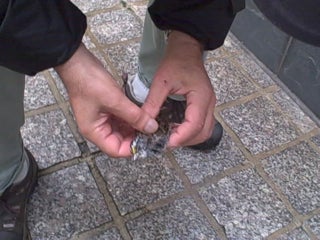
Levin found his first two birds at the same spot – in the seating area surrounding an atrium. The seating area contains large planters with shrubs and plants, and there is a row of small trees on two sides of the glass structure. The seating area was closed on Levin’s first two walks around his monitoring area. The third time around, he found a small, olive-colored bird lying on its side about two feet from the wall of glass.
“Oh, no,” he said, walking over to pick it up. He noted on his worksheet that the bird was cold when he found it, but not yet entirely stiff.
Levin also wrote some information about the bird and where he found it on a label that he stuck to a sandwich bag. He carefully placed the bird inside. “May your soul come back in somebody else,” says. Levin tucked the bird into his backpack, and resumed his mission.
Forty minutes after finding the first bird, Levin found a second one on the opposite side of the same property.
“There must be something to this,” he said. “I’ve found all of my birds here.”
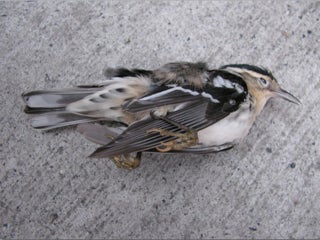
Levin repeated the same information recording steps as with the first bird. “Rest in peace, little soul,” he said, placing it in his backpack.
Russell doesn’t yet know how many birds have been found – he won’t compile that data until this season’s study period ends at the end of May. On some days, volunteers find no birds at all, he said. One of the Temple volunteers recently found nine birds in one day.
The volunteers will not find every bird that dies along their route. Some are eaten by other animals. And some never make it to the ground. They hit a building’s upper floors, Russell said, and land on a balcony or ledge.
On his way back home to Fairmont, Levin stopped at the Academy of Natural Sciences, where all the monitors drop off the birds. There, they go into a freezer. Later, Nate Rice, the ornithology collection manager will add them to the Academy’s vast collection of study specimens.
When peak migration ends later this month, Russell will examine the bodies of the birds that were found and gather all the volunteers’ worksheets to compile the data.
He hopes to do this for several more migration seasons so that he has a significant amount of data to present to building owners and city officials. Because Temple volunteered to participate, Russell said they will likely try to find solutions for the problem there before the study period ends. It would be great, he said, to have some successful examples of how to curb the problem to take to others around the city.
Anyone who would like their building to be part of the study, or who has noticed a problem with dead birds during migration season and wants help solving it, may contact Russell at krussell@audubon.org.
Contact the reporter at kelliespatrick@gmail.com
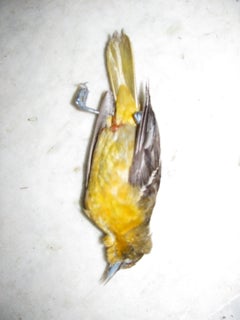
Baltimore Oriole
WHYY is your source for fact-based, in-depth journalism and information. As a nonprofit organization, we rely on financial support from readers like you. Please give today.



